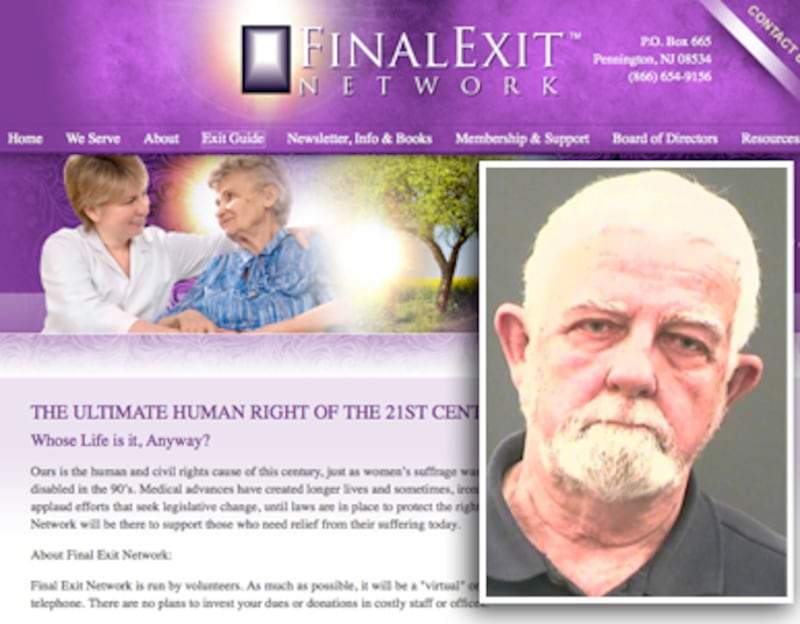In 2007, Jana Van Voorhis, a wealthy 58-year-old Phoenix woman who believed she was being nocturnally attacked by rats and had holes in her liver, suffocated herself with helium.

Two years later, Arizona authorities charged four volunteers for Final Exit Network, a Georgia-based right-to-die nonprofit that is an offshoot of the Hemlock Society, with two felonies each in connection with “aiding” Van Voorhis’ suicide. Among those charged was retired Baltimore anesthesiologist Lawrence Egbert, one of the founders of Final Exit Network who has been dubbed “The New Dr. Death” for his libertarian right-to-die views.
This week a Maricopa County Superior Court jury in Phoenix came out with a confounding verdict. The jury acquitted Egbert, 83, but could render no verdict on whether Franklin Langsner, an 86-year-old Final Exit Network volunteer, “aided” the helium-induced suicide.
Unlike the first “Dr. Death,” Jack Kevorkian, the Detroit doctor who was convicted of second-degree murder and served eight years in prison for helping a man with advanced ALS euthanize himself, Egbert did not lay a hand on Van Voorhis. Instead he was a volunteer medical director for Final Exit Network. He approved cases of those Final Exit members who wanted to “exit.”
Although Egbert’s been acquitted in the Arizona case, his legal troubles are far from over. Along with three other Final Exit volunteers not related to the Arizona case, Egbert faces criminal charges in Georgia in connection with allegedly assisting in the suicide of a Georgia man with advanced and debilitating jaw cancer. All four defendants in the upcoming Georgia case have pleaded not guilty.
Although Egbert’s been acquitted in the Arizona case, his legal troubles are far from over.
In the Arizona case, Egbert was not present at Van Voorhis’s bedside. But prosecutors said Langsner, a World War II vet and retired college professor who lives in Scottsdale, served as a volunteer “exit guide” and was in Van Voorhis’ home when she died. Prosecutors said Langsner “aided” Van Voorhis with her suicide by advising her on the necessary equipment (helium tanks of the sort that fill party balloons and a “helmet”), staying with her in her house as she died, then helping pitch the helium tanks and the helmet into a Dumpster.
Langsner pleaded not guilty to all charges, and the Phoenix jury members “ argued loudly” as they debated his guilt. Since they couldn’t render a verdict, it’s likely Maricopa County prosecutors will retry the case or agree to a plea deal. (A spokesman for the county attorney’s office did not return a phone call seeking comment for this story.)
Langsner’s Phoenix attorney, Antonio Bustamante, says Langsner served two tours during World War II, working medical detail for the Navy. He portrays his client as an innocent man, and says the case, however it turns out, will have a lot to say about how society treats those who are “so desperate, usually because of a medical condition,” to end their own lives.
In addition to Langsner, Wye Hale-Rowe, an 83-year-old “senior exit guide” from Colorado, was also present at Van Voorhis’ deathbed. Hale-Rowe pleaded guilty to a lesser charge and testified against Langsner and Egbert. A fourth Final Exit volunteer, New Jersey resident Roberta Massey, a “case coordinator,” also pleaded guilty to reduced charges in the Arizona case. Both Massey and Hale-Rowe have yet to be sentenced.
Van Voorhis was not terminally ill, her family members told Phoenix New Times in 2007, but she was mentally disturbed and trending toward serious psychosis. Still, by Final Exit Network standards, she apparently qualified for her self-induced exit.
“Mentally competent adults have a basic human right to end their lives when they suffer from a fatal or irreversible illness or intractable pain, when their quality of life is personally unacceptable, and the future holds only hopelessness and misery,” the Final Exit Network’s website says.
Van Voorhis’ suicide could not have been pretty. Egbert told Newsweek last year he’d witnessed plenty of suicides, and in helium-suffocation deaths, “The person starts turning blue, they're gasping for breath ... it's scary.”
Terry Greene Sterling is an award-winning Arizona-based journalist and author of ILLEGAL, Life and Death in Arizona's Immigration War Zone. Visit her on Facebook, or her website.





